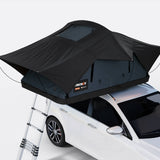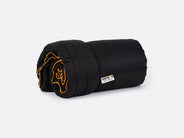Understanding vehicle roof load limits for roof tents
Summary
What TentBox model will work with my roof load limit?
Your dynamic roof load limit needs to be equal to or greater than the weight of the TentBox you are installing. For example, if your dynamic roof load limit is 50kgs, you can install a TentBox Lite 2.0 as it weighs 50kgs.
You can find the weight of each TentBox on the respective product pages, or by using our TentBox comparison tool.
What is a dynamic roof load limit?
The dynamic roof load limit is the amount of weight your vehicle can take on the roof whilst driving.
How do I find the dynamic roof load limit for my vehicle?
You can usually find the dynamic roof load limit for your vehicle in the user manual, but not always; often it is easier to do a google search such as 'roof load limit for a volkswagen passat'.
If a google search doesn't work, we recommend using a really helpful tool provided by www.car.info, who have a comprehensive database of almost every car spec for every vehicle.
How to use car.info to find your dynamic roof load limit:
- Visit www.car.info
- Enter your car into the search bar at the top, select the model
- Select the correct year for your car,often there are pictures to help
- Select the engine size, this doesn't really matter for roof loads
- When the specs appear, click 'more'
- Find the 'Weight' section, and look for 'Max roof load' This is the dynamic roof load limit.
If you would like us to find the roof load limit for your car, contact our product specialists.
What is a static roof load limit?
The static roof load limit is the weight a vehicle can take on the roof whilst stationary i.e. when you're not driving. The static (stationary) load limit will typically be 3-5 times higher than the dynamic limit.
This is an important consideration for roof tents, because when you are using them you will have the added weight of people inside, but this will only be when you are stationary.
Most cars manufactures don't list the static roof load limit, because it is not useful for any other application other than a roof tent. In other words, there are no applications whereby you will need a heavier load on the roof when stationary versus when you are driving.
Interestingly, as roof tents gain popularity, some vehicle manufacturers, such as Subaru, have started to list the static roof load limit.
How do I find the static roof load limit for my car?
The best way to find your static roof load limit is to multiply your dynamic roof load limit by 3-5. So if your car has a 50kg dynamic roof load limit, your static limit would be 150kg to 250kgs.
The reason for this, is that the forces exerted on your car roof when driving are amplified by at least 3-5x compared to when it is stationary. This is due to cornering, breaking, hitting bumps in the road, entering an incline in the road.
In other words, the force exerted on a car roof when driving with 50kgs of weight on top is the equivalent to the force of having at least 150kgs (3x) to 250kgs (5x) of weight on when top when the vehicle is stationary.
This has not only been calculated by our own engineers, but we have also spoken with car companies directly who have confirmed this to be accurate.
What about the added weight of people inside the roof tent?
The static (stationary) load limit will typically be 3-5 times higher than the dynamic limit, so the added weight of people inside the roof tent can be handled easily by your car roof. You will only have people inside the TentBox when your car is stationary, so it is only the static roof load that you need to consider for this part.
Remember, car roofs are designed to withstand an accident whereby the car rolls over and doesn't crush. The roof bars are fixed directly to the steel frame of your car, and the frame is an extremely solid structure.
How do I get help with car roof load limits?
Our team of roof tent experts would love to help you if you still have questions or need any advice at all. Please contact us here if you want to talk, we'd love to hear from you.











